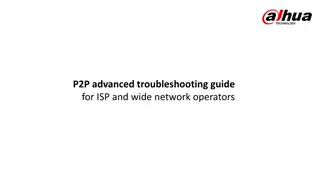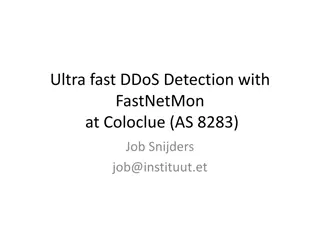Rescue Drone: Increasing Autonomy and Implementing Computer Vision
Focuses on developing a rescue drone with increased autonomy and implementing computer vision for advanced object detection. The team, consisting of Cody Campbell (Hardware Engineer), Alexandra Borgesen (Computer Engineer), Halil Yonter (Team Leader), Shawn Cho (Software Engineer), Peter Burchell (M
78 views • 44 slides
Comprehensive Guide for Visa, Residence Permit, Subsistence Allowance, and Insurance for International Science Programme at Uppsala University
This guide provides essential information on obtaining a visa/residence permit, requesting support documents from ISP, acquiring subsistence allowance, handling insurance, navigating weather conditions, and accessing important web pages for students participating in the International Science Program
0 views • 19 slides
Understanding Technology Concepts for Year 7 Students
Explore essential topics such as Formulas, Cell References, Inputs, Outputs, Web Browsers, Storage, Embedded Computers, ISP, Portable Computers, Hardware Components, Data vs. Information, and more. Enhance your knowledge in the world of technology!
4 views • 4 slides
Identifying Student Percentage Reporting SY 2021 - 2022
Identified Student Percentage Reporting (ISP) is essential for districts to report the number of students identified through direct certification and categorical lists in eSchool. This report must be submitted by April 15, 2022, to comply with federal regulations. Understanding how ISP is calculated
1 views • 12 slides
Understanding Change in Status & ISP Training for Support Coordinators
This training focuses on ensuring Support Coordinators understand and apply the critical concepts of change in status and ISP implementation appropriately. Supervisors play a key role in supporting SCs in this process. By the end of the training, participants will be able to identify, assess, docume
0 views • 45 slides
Understanding Internet Tools and Terminology
The Internet is a global network of interconnected computers utilizing the TCP/IP communication method. It includes the World Wide Web, browsers for accessing content, servers for data transfer, websites with webpages displayed via web servers, URLs for addressing resources, and protocols like SMTP,
2 views • 6 slides
Advanced Troubleshooting Guide for P2P Connectivity in ISP and Wide Networks
This troubleshooting guide is tailored for operators, network experts, and engineers dealing with Dahua P2P NAT traversal protocol issues. It covers different types of NAT, including Full Cone NAT, Restricted Cone NAT, Port Restricted Cone NAT, and Symmetric NAT, providing insights and solutions for
0 views • 17 slides
Crisis Counseling Assistance and Training Program (CCP) Overview
The Crisis Counseling Assistance and Training Program (CCP) offers short-term disaster relief grants to states, U.S. territories, and federally recognized tribes. CCP grants support community-based outreach by training local individuals to provide services such as crisis counseling and emotional dis
0 views • 26 slides
Efficient Supplier Portal for GE Transportation/Wabtec iSupplier Training
GE Transportation/Wabtec offers a user-friendly iSupplier Portal (iSP) for suppliers to manage invoices, payments, and orders efficiently. Learn how to register, receive system updates, and ensure compliance for seamless transactions. Access web invoicing, credit card processing, and ERS settlement
0 views • 16 slides
Virginia Department for the Deaf and Hard of Hearing (VDDHH) Programs and Services
The Virginia Department for the Deaf and Hard of Hearing (VDDHH) promotes accessible communication for individuals who are Deaf and hard of hearing to participate fully in programs, services, and opportunities throughout the Commonwealth. Services include Technology Assistance Program (TAP), Interpr
0 views • 15 slides
Guide to Entering Part V Plans in WaMS
Learn how to incorporate Part V Plans into WaMS through manual entry and understand the process of adding outcomes, support instructions, service authorizations, and more. Follow step-by-step instructions and visual aids to successfully complete Part V Plans in the ISP.
0 views • 47 slides
Impact of Carrier-Grade NAT on Web Browsing: A Comprehensive Analysis
The research delves into the effects of Carrier-Grade NAT on web browsing, discussing traditional NAT mechanisms, deployment implications of Carrier Grade NAT, and investigation goals. Methodologies for large-scale passive measurement in real ISP deployments are outlined, focusing on monitoring web
0 views • 25 slides
Understanding DNS Performance and Issues in Information-Centric Networks
DNS (Domain Name System) plays a crucial role in the Internet and web infrastructure, impacting scalability and content delivery. This content delves into DNS issues, comparing ISP DNS with Google DNS and OpenDNS in terms of latency, caching, and performance with CDNs. It explores how caching, third
0 views • 12 slides
Individually-Based Limitations: Process and Documentation
Individually-based limitations (IBLs) are addressed in the Individual Service Plan (ISP) to manage health and safety risks for individuals in provider-owned residential settings. The implementation process involves collaboration and documentation within the ISP planning process. IBLs can be initiate
0 views • 40 slides
Enhancing Internet Connectivity: Peering Personals Guide
Discover how to create and submit Peering Personals slides effectively. Select templates based on your category, fill in details, and await confirmation for the opportunity to present your network connectivity at the APRICOT2024 event. The guide includes information on ISP/OTT/CDN/Research, IXP, Dat
0 views • 15 slides
Evolution of Networking: Embracing Software-Defined Networks
Embrace the future of networking by transitioning to Software-Defined Networks (SDN), overcoming drawbacks of current paradigms. Explore SDN's motivation, OpenFlow API, challenges, and use-cases. Compare the complexities of today's distributed, error-prone networks with the simplicity and efficiency
0 views • 36 slides
Understanding IPv6 ISP Performance: A Detailed Analysis by Geoff Huston
This comprehensive study explores the reliability and speed of IPv6 connections, highlighting factors affecting connection failures. It compares datasets from 2011 and 2015/2016, revealing insights on Teredo, 6to4, and unicast address failures. The findings underscore the importance of addressing is
0 views • 37 slides
Understanding the Internet: A Comprehensive Overview
The internet is a globally connected network system that allows worldwide communication and access to data resources. It is governed by agencies like IANA, and connecting a computer to the internet enables access to information, communication globally, and more. The internet is a global wide area ne
0 views • 17 slides
Workday@Yale Program Updates & People Hub Summary
This document provides details on the Workday@Yale program updates and People Hub agenda for March 6, 2017. It covers program updates including Spend/Revenue Categories for ISP Journals, COA Converter usage, Web Service Definitions, Testing Reminders, and Deployment Future Forum Topic. Additionally,
0 views • 21 slides
Understanding Router Design and Longest Prefix Matching in Computer Networks
Explore concepts like control plane processors, route lookup, and IP block reallocation in computer networking. Learn about the basics of forwarding tables, scheduling, and buffer management crucial for network operations. Dive into routing algorithms and data plane processing for efficient packet d
0 views • 39 slides
DNS Openness - Exploring the Impact of DNS Regulations on Information Access
DNS openness is essential for unrestricted access to information and services. However, varying regulatory requirements and ISP practices result in different DNS resolutions globally, impacting user experiences. Despite these challenges, threats like malware mitigation justify such deviations from a
0 views • 41 slides
Ultra-Fast DDoS Detection with FastNetMon at Coloclue
Discover how Coloclue, a non-profit ISP, leverages FastNetMon and automation to detect and mitigate DDoS attacks within seconds, automating the problem away and protecting their network effectively. With 2 datacenters, 4 routers, and a volunteer-driven approach, Coloclue successfully defended agains
0 views • 16 slides





















